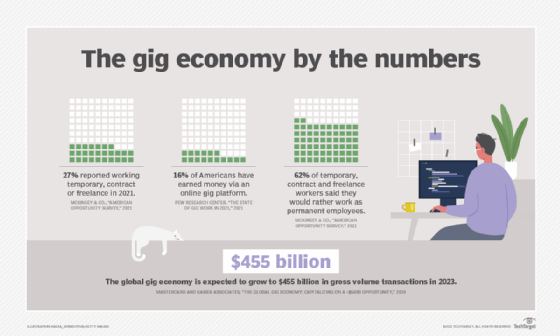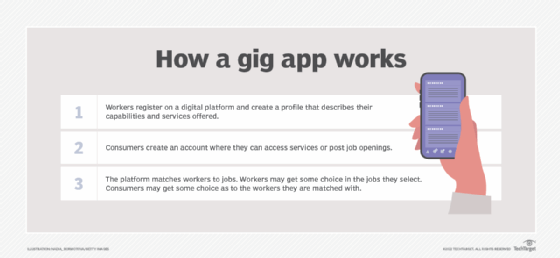What is the gig economy?
A gig economy is a free market system in which temporary positions are common and organizations hire independent workers for short-term commitments. The term gig is a slang word for a job that lasts a specified time. Traditionally, the term was used by musicians to define a performance engagement.
Today, however, examples of gig workers include freelancers, independent contractors, project-based workers and temporary or part-time hires. Furthermore, gig apps and digital technology are often used to connect customers and gig workers across various industries.
Several factors have contributed to the rise of the gig economy, such as the following:
- Increased workforce mobility. Workers are no longer tied to a single employer or location.
- Remote work enabled by digital platforms. Jobs can be performed from anywhere, allowing businesses to hire talent globally.
As a result, jobs and locations are being decoupled. That means freelancers can take a job or project with an employer anywhere in the world. At the same time, employers can select the best person for a specific project from a larger pool than is available in any given area.
The gig economy is part of a shifting cultural and business environment that also includes the sharing economy, barter economy and remote work culture. The cultural impact of the gig economy continues to change. For example, the COVID-19 pandemic significantly affected hiring trends, directly impacting the gig economy.
Who is part of the gig economy?
The gig economy is made up of companies, workers and consumers. All gig workers aren't the same. They include the following:
- Freelancers. Paid per task or project.
- Independent contractors. Work on a contract basis.
- Project-based workers. Hired for specific projects.
- Temporary hires. Employed for a set duration.
- Part-time workers. Work fewer hours than full-time employees.
The gig economy provides consumers with an alternative to commercial products and industries. They turn to the gig economy for convenience, better service, or both. This is the case with ride-hailing apps, like Uber and Lyft, and food delivery services, like Grubhub and DoorDash. Gig apps have also met consumer demand where a service is in short supply or expensive. Airbnb has played this role in places where hotel rooms are in short supply, making more temporary accommodations available, sometimes at lower prices.

Common gig economy jobs and industries
Gig economy jobs include familiar positions found in diverse industries, including the following:
- Accounting and finance. Independent consultants and mortgage representatives.
- Administration. Administrative assistants.
- Art and design. Musicians or graphic designers.
- Construction. Carpenters and other construction trades.
- Education. Substitute instructors and tutors.
- Freelance writing. Content writers and copywriters.
- Information technology. Various jobs, such as information security engineers and network analysts.
- Media and communications. Technical writers and photographers.
- Project management. Project or office manager jobs.
- Software development. DevOps engineers and user experience
- Transportation. Ride-hailing drivers.

Perks of the gig economy
The benefits of the gig economy vary, depending on whose perspective you take -- the business, worker or consumer.
The business
In a gig economy, businesses save money and resources. They aren't responsible for providing employee benefits, such as sick leave and health insurance, and they often don't have to provide workers with office space, equipment and training. A gig model also enables a business to contract with experts, who might be too expensive hire as full-time staff, for specific projects.
The worker
From the worker's perspective, a gig economy can improve work-life balance compared with many traditional jobs. Independent workers can select freelance jobs that they are interested in, provide new opportunities, and look right for their preferences and schedule. They don't get stuck in a full-time job that doesn't interest them or have the flexibility they need. This sort of freelance economy also lets workers choose when they want to work and helps them avoid being locked in to or dependent on a single employer.
The consumer
Consumers often find that a gig model provides more choices and convenience in personal services offered. In many cases, services are of higher quality and offered at lower prices. Services are also offered more flexibly, and there are more choices in service providers, as well as times and locations of offerings.
Issues with the gig economy
Despite all the advantages, the gig economy has considerable downsides, including the following:
- Lack of benefits. This might be the biggest downside. Gig workers are typically not eligible for health insurance or other benefits they would get working as a full-time employee. Also, companies are typically not required to pay temporary workers minimum wage or overtime.
- Work-life management challenges. Gig work can be disruptive if the worker isn't used to making their own schedule. Inexperienced workers can easily take on too many gigs, leading to overwork and burnout.
- Insecurity and inconsistent income. Having enough work to maintain a stable income is a challenge with gig work.
- Work culture. Temporary workers who come and go in an organization make it difficult to maintain consistent relationships among workers, employers and clients on a long-term basis.
- Effect on the job market. When temporary positions are all that is available, workers can find it difficult to establish and develop their careers.
What impacts the gig economy?
Shifting political, cultural and business environments affect the gig economy.
The pandemic and the gig economy
In 2020, the gig economy began changing due to COVID-19. The University of Chicago's Harris School of Public Policy and the Associated Press-NORC Center for Public Affairs Research conducted a survey in 2020 on consumer attitudes toward ride-hailing and delivery services. The survey found a divided user base.
Americans with higher incomes were more likely to use delivery services to reduce their risk of infection. The survey found that 26% of households with annual incomes of $100,000 or more have increased their use of these services, while only 12% of those with incomes under $50,000 have done so.
Among customers who previously used ride-hailing services, 63% said they had not used the service since March 2020, and 54% said they feel uncomfortable using a ride-hailing service during the COVID-19 outbreak.
Digitization and the 'virtual-only' impact on the gig economy
The rapid advancement of digital technology, including AI and automation, has had a significant impact on gig work. Many companies have embraced virtual-only business models, reducing the need for physical storefronts and traditional employment structures.
A prime example of this trend is MrBeast Burger, a virtual-only restaurant that leverages gig workers for food preparation and delivery while relying on digital marketing strategies for customer engagement. This model allows restaurants to expand revenue streams and test new menu items without affecting their primary brand or requiring additional infrastructure.
Beyond the food industry, digital platforms such as Fiverr, Upwork and TaskRabbit continue to reshape gig employment by connecting workers to global opportunities. However, automation and AI-driven tools are also reducing demand for some gig-based roles, particularly in customer service, content automation and data processing.
Changing flexibility needs and the gig economy
As previously mentioned, the pandemic increased financial pressures on businesses, prompting many companies to shift toward more flexible employment models that rely on gig workers. Instead of hiring full-time employees, businesses turned to freelancers and independent contractors who could be quickly scaled up or down based on demand.
Gig work provides flexibility not just for businesses but also for workers. Many individuals who lost full-time jobs during the pandemic turned to gig platforms for supplemental income or as a primary source of employment.
Industries such as e-commerce, logistics and home services saw particularly high demand for flexible workers. Companies like Amazon Flex, Instacart, and Shipt expanded their gig workforce to meet consumer demand for faster delivery and on-demand services.
However, this increased reliance on gig labor has also raised questions about worker rights, job security and access to benefits, leading to debates over employee classification laws such as California's Assembly Bill 5 (AB5) and subsequent legal rulings that affect gig worker protections.
Generational effects on the gig economy
The gig economy has been heavily influenced by generational shifts in the workforce. Millennials and Generation Z (Gen Z) workers tend to prefer flexible, project-based work over traditional nine-to-five jobs.
Several factors contribute to this preference:
- Desire for work-life balance. Younger workers prioritize flexible schedules over rigid corporate structures.
- Technological adaptability. Digital natives are more comfortable using gig platforms for freelance, remote and side-hustle opportunities.
- Entrepreneurial mindset. Many Gen Z and Millennial workers prefer independent work, viewing the gig economy as a stepping stone toward self-employment or business ownership.
At the same time, older generations are also participating in gig work, but often for different reasons. Many retirees and late-career professionals turn to gig jobs for supplemental income or to stay active in the workforce without committing to a full-time role.
As younger generations continue to dominate the workforce, the gig economy is likely to evolve further, driven by advancements in technology, remote work, and non-traditional employment structures.
The gig economy has transformed the way people work, offering flexibility, independence, and new opportunities for businesses and workers. However, this shift also brings challenges, including job insecurity, lack of benefits and regulatory concerns.
As businesses increasingly rely on gig workers to remain agile and cost-efficient, debates surrounding worker rights, classification and fair compensation will persist. Additionally, generational preferences will continue to drive the gig economy's evolution, with Millennials and Gen Z leading the charge toward flexible, tech-driven work models.
Meanwhile, companies must find a balance between efficiency and worker protections to create a sustainable gig economy that benefits all stakeholders. As the landscape continues to evolve, workers, businesses and policymakers must adapt to ensure that the gig economy remains a viable and equitable model for future employment.
With digital platforms and flexible work arrangements, people are discovering new ways to earn money. Two forms of economies -- the gig economy and the creator economy -- provide alternative income opportunities. Learn about the difference between the gig economy vs. the creator economy.